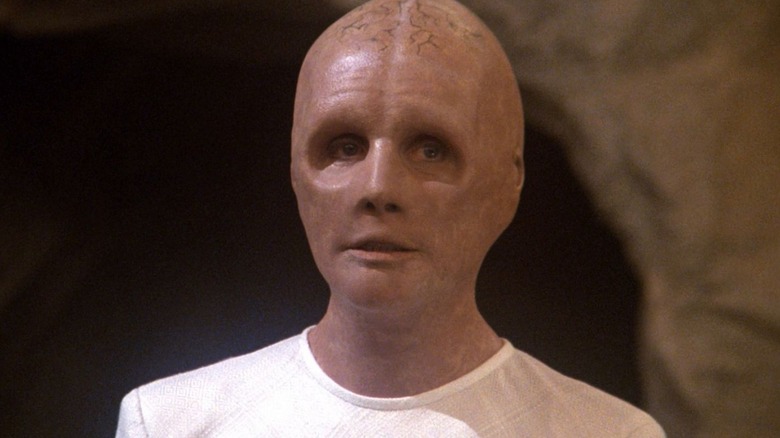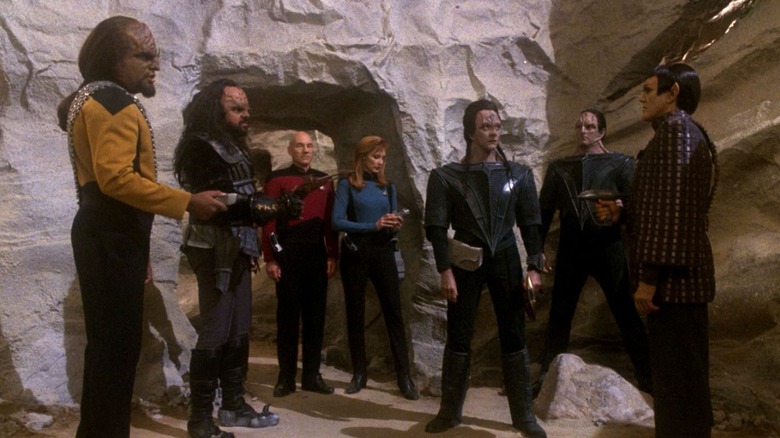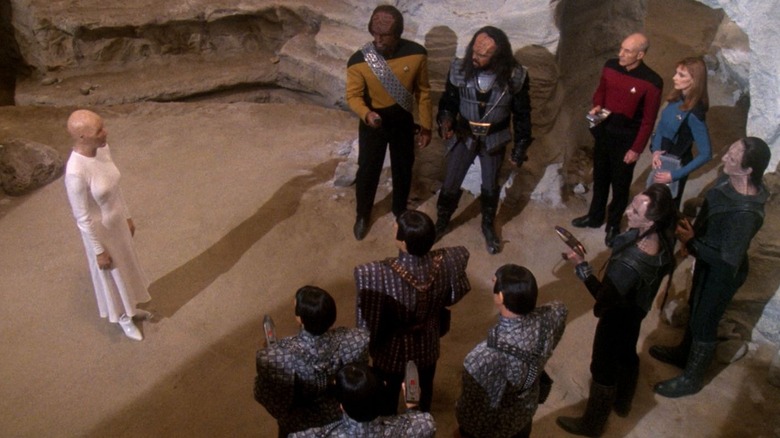Star Trek: TNG's The Chase Was Already A Struggle – Then Its Budget Was Stolen By DS9
Practically speaking, there's a reason why most aliens on "Star Trek" are humanoid. Not only are they humanoid, but they all share very similar specific features: two legs, two arms, two eyes, one mouth, teeth, and/or hair. Many aliens look identical to humans apart from ridges on their foreheads or elaborate skin markings. This is because all the aliens on "Star Trek" are played by human actors. Very occasionally, Captain Kirk (William Shatner) might encounter a Melkot or a Tholian who were achieved through puppetry or photographic effects, but for the most part, aliens were played by Earth's boring ol' Homo sapiens actors.
By the time the "Star Trek: The Next Generation" episode "The Chase" aired on April 26, 1993, Trekkies had been watching the franchise long enough to ask why — from an in-canon perspective — all aliens looked like humans. "The Chase" came up with a cute (if not wholly satisfying) canonical excuse as to why Trek evolutionary biology favored human shapes: it seems all humanoid species share a common ancestor. As the lore goes: billions of years ago, the galaxy's first sentient species evolved on a distant planet. They explored the universe in ultra-high-speed space vessels but found no neighbors. To rectify the situation, they seeded millions of worlds with their DNA, assuring other species would evolve similarly in millions of years. It's not great, but it's something.
In the oral history book "Captains' Logs: The Unauthorized Complete Trek Voyages" edited by Mark A. Altman and Edward Gross, various NextGen showrunners admitted that "The Chase" was hard to hed a handle on, and that the script underwent many changes. Most damning was when "Star Trek: Deep Space Nine," running concurrently, siphoned a lot of NextGen's budget. A lot of cuts and concessions had to be made.
Deep Space Nine was too expensive
Longtime Trek executive producer Rick Berman noted that the script for "The Chase" had been kicked around the Paramount offices for years, with no writer able to unlock it or make the story work. Even when the script finally came together — ultimately credited to Ron D. Moore and Joe Menosky — it still didn't quite satisfy him. He said:
"It's a story that's been around forever. It was similar to 'Darmok,' which was a story that was around forever also. 'Darmok' never worked for me until Joe came up with the direction that he came up with ... and it turned out to be one of my favorite episodes of all time. This story did not. Conceptually, it's very interesting. I always had some problems with dealing with the whole idea of these kind of prehistoric creatures who are the fathers of us all. It's not Roddenberry-esque, it's very '60s Roddenberry-esque."
"Darmok" (September 30, 1991) is a beloved episode about an alien species, the Tamarians, who communicate exclusively through cultural metaphors. It's a great episode.
Executive producer Michael Piller noted that Menosky delved far too deeply into technobabble, saying, "You turn the page and it begins to go into the tech. One of the great talents of Menosky has always been his ability to see places the rest of us wouldn't even go to look and from page 20 to page 60 he was on a different plane, existing somewhere else." Piller repeatedly returned the script to Menosky saying "he didn't get it."
Even Ron D. Moore admits that he couldn't quite crack the story as what he originally envisioned would be too expensive to realize. And then, even after cutting it down, "Deep Space Nine" started sapping up money.
Jonathan Frakes directed The Chase
"The Chase" was directed by cast member Jonathan Frakes, and he was upset with the episode as well. He noted that the episode's finale, as seen in the above photo, had to be shot on a soundstage and not on location, and that it looked cheap. The finale involved a group of Klingons, a group of Romulans, a group of Cardassians, and several Starfleet officers gathering around to witness an impossibly ancient hologram of a humanoid progenitor (Salome Jens) explaining her species' need to seed millions of worlds. Frakes pointed out that Jens and several of the episode's guest aliens were terrific, especially John Cothran, Jr. as a Klingon and Maurice Roeves who played a Romulan. But, he added:
"I was very disappointed not to get to shoot outside. [...] I think it does look like Planet Hell, but that's the way it goes. The money was being spent across the street [at 'Deep Space Nine']. I don't think it's a secret."
"Planet Hell" was a nickname the Trek cast and crew gave to an often-reused indoor cave set that stood in for multiple alien worlds. The set infamously looks cheap and artificial and was never as convincing as an alien catacomb. It seems that if "Deep Space Nine" hadn't been in production at the same time; the new series premiered a few months earlier, and Paramount was clearly more concerned with their new baby than their old friend.
But then, maybe Planet Hell was the preferable option. Location shoots typically brought the "NextGen" crew to Topanga Canyon, Vasquez Rocks, or some other locale in Southern California ... and it always looks like Southern California. A fake set, at the very least, looked more alien.


